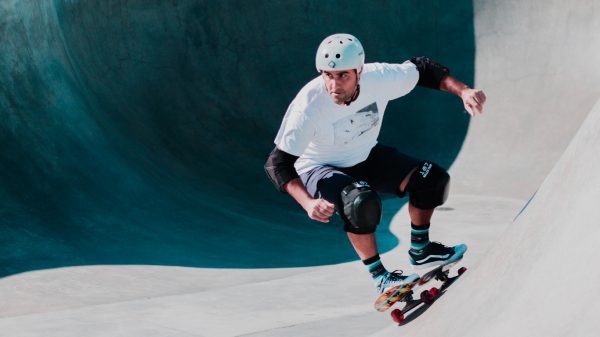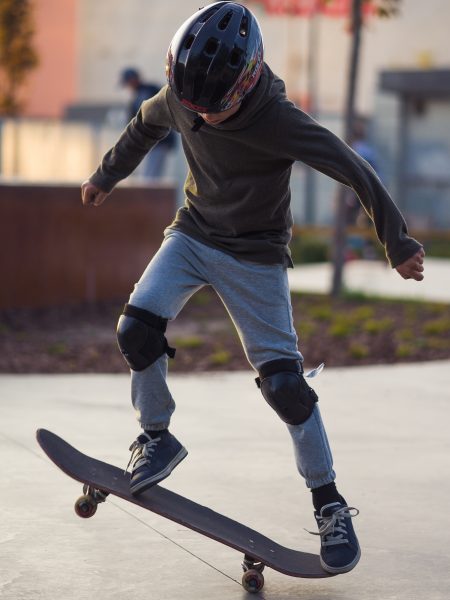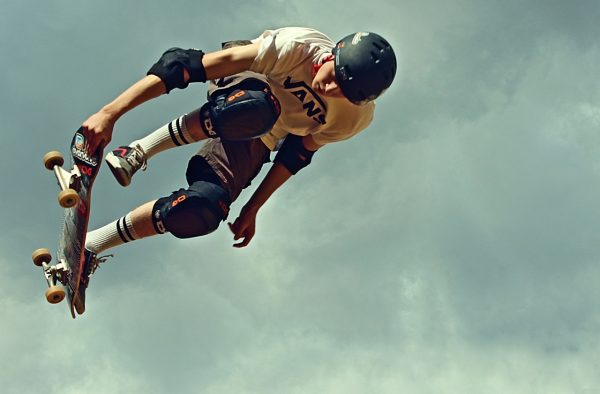Electric skateboard safety equipment.

One of the best ways to shop is to compare boards to their safety features and speed range. In this article, we’ll guide you in finding the right skateboard for you base on these elements.
Prioritize Safety
Safety is the best companion when skateboarding, especially for kids. It begins with the essential helmet to ensure a secure ride on their basic electric skateboards. A certified sweatsaver helmet is an excellent choice to protect your head with comfort and style.
Skateboarding, with its adrenaline-pumping tricks and daring maneuvers, has captivated the hearts of people worldwide for decades. From amateurs to seasoned professionals, enthusiasts take to the streets and skate parks, seeking the thrill that comes with mastering this dynamic sport of skateboarding. However, amidst the excitement and artistry, there lies an essential aspect that every skateboarder must prioritize: skateboarding safety.
Skateboarding, by its nature, involves risks, which is why you need to make basic electric skateboards as safe as possible. Whether you’re a beginner or a seasoned skateboarder, the potential for falls and accidents remains a constant reality. Yet, with the right mindset and the proper protective gear, skateboarders can significantly reduce the likelihood of severe injuries and enhance their overall skateboarding experience. Investing in knee and elbow, helmets, pads, and the 187 Killer pads is crucial for safety.
This article delves into the world of safety gear investments for basic electric skateboards. We will explore the key safety gear that every skateboarder should consider, from certified skate helmets that safeguard the brain to the knee, and elbow, and 187 Killer pads that shield vital joints. Additionally, we’ll examine the importance of investing in well-fitting shoes, padded clothing, and wrist guards to protect against common injuries. High-quality Lifer Helmet and Sweatsaver Helmet options are available to ensure you stay safe while skateboarding.
By understanding the significance of each protective component and learning how to make informed choices when selecting safety gear, skateboarders can create a solid foundation for a safer, more enjoyable journey. So, let’s delve into the world of safety gears and compare boards, where precaution and passion intertwine, allowing skateboarders to confidently shred the streets while keeping their well-being in check. Top best-selling brands offer single high and dual-certified helmets that can withstand multiple impacts and high-impact falls, providing excellent protection.
Key Takeaways
- Investing in a high-quality Sweatsaver Helmet for electric skateboards is essential for protecting yourself from potential injuries and accidents. A complete pad set with knee and elbow pads, wrist guards, and other protective items is necessary to shield joints and prevent abrasions during falls or tricks. Additionally, ensure you have helmets, pads, grip tape for skate protection, and other accessories that meet safety standards.
- Investing in a high-quality helmet is the most crucial piece of gear. Electric skateboard helmets provide critical head protection, and certified sweat-saver options are among the best-selling for their effectiveness. Whether you’re involved in roller skating, using inline skates, or skateboarding, certified skate helmets like the Lifer Helmet offer reliable protection. Padded clothing, such as shorts or pants, can protect hips and the tailbone from impacts, while long-sleeved shirts offer arm protection.
- Knee pads, elbow pads wrist, and wrist guards are essential to protect joints and prevent abrasions during falls or tricks.
- Skateboarding shoes provide better grip and support compared to regular shoes, enhancing stability while riding.
- Proper maintenance of your long gear and hub motor ensures its effectiveness and longevity. We also recommend having grip tape over your skate’s tip to protect it from rough surfaces.
- Regularly check for wear and tear, loose straps, or damaged skateboard parts. Replace grip tape as often as necessary.
- Replace safety gear as needed, especially for growing or changing body sizes in younger skateboarders.
- Comply with safety standards and stay up-to-date with the latest guidelines to ensure optimal protection.
- Prioritizing safety sets a positive example for the community and promotes a responsible culture.
- Enjoy skateboarding with confidence and peace of mind, knowing you have reliable protection while skateboarding.

Safety in skateboarding is crucial as the sport carries inherent risks. Proper protective equipment, such as helmets, knee, grip tape, elbow pads, and wrist guards, significantly reduces the chances of serious injuries like concussions, fractures, and sprains. Prioritizing safety also protects vital skateboard parts, promotes confidence, and fosters skill development.
Guidelines For Purchasing Protective Skateboard Gear

When purchasing protective gear, there are several important tips and guidelines to keep in mind to ensure you get the best gear and pad set for your safety. Here are the key tips and guidelines:
- Research Reputable Brands: Look for protective gear from well-known and reputable brands that specialize in action sports. Established brands often have a record of producing high-quality, reliable skateboarding gear.
- Check Standards for a Safe Ride: Ensure that the gear you’re considering meets relevant protective standards, such as ASTM F1492 or CPSC certification for helmets. Meeting these standards ensures that the equipment has undergone testing and meets specific safety requirements.
- Choose Equipment Specifically Made for Riding a Skateboard: Opt for safety gear designed explicitly for skateboarding or other action multi-sport. Skateboarding gear is engineered to withstand the impacts and abrasions common in skateboarding.
- Properly Fitting Equipment: Proper fit is crucial for the effectiveness of the gear. Try on different sizes to find gear that fits snugly but comfortably. A multi-sport helmet should sit level on your head and cover your forehead without obstructing your vision.
- Consider Complete Equipment Sets: Many brands offer complete sets of safety gear that include helmets, knee pads, elbow pads, and wrist guards. Buying a set ensures consistency in quality and fit across all the components.
- Read Reviews and Testimonials: Look for reviews and testimonials from other skaters who have used the safety gear you’re interested in. Their experiences can provide valuable insights into the effectiveness and durability of the equipment.
By following these tips and guidelines, you can confidently select the right safety gear for your skateboarding adventures, significantly reducing the risk of injuries and ensuring a safer and more enjoyable experience on your skateboard.
Protective Skateboard Gear
Investing in the right safety gear is crucial for protecting yourself while riding. Here are the essential gear items that are best to invest in:
- Helmet: A high-quality helmet is the most critical piece of safety equipment. Look for helmets that meet safety standards such as ASTM F1492 or CPSC certified. Ensure a proper fit that covers your forehead without obstructing your vision.
- Knee Pads and Elbow Pads: Knee pads and elbow pads protect your joints from impacts and abrasions during falls or tricks. Choose pads designed specifically for action sports, with durable materials and secure straps.
- Wrist Guards: Wrist guards are essential for protecting your wrists from fractures and sprains during falls. Look for guards with good impact absorption and a secure closure system.
- Skateboard Shoes: Invest in quality skateboarding shoes that provide excellent grip and support for your feet. Skate shoes are specially designed to withstand the wear and tear of skateboarding and offer better protection than regular shoes.
- Padded Clothing: Consider wearing padded shorts or pants to protect your hips and tailbone from impacts. Long-sleeved shirts can also provide some protection for your arms. Buying a pack pad set ensures consistency in quality and fit across all the components.
- Mouthguard: While not as common as other safety gear, a mouthguard can be beneficial for protecting your teeth and mouth from potential injuries.
- Slide Gloves (for skateboarding): If you ride an electric longboard, slide gloves with palm and finger pucks are crucial for protecting your hands during slides and stops. An electric longboard can go quite fast and without proper grip or protection, your hands could scratch rough surfaces when trying to brake.
Maintenance And Replacement Of Protective Gear
Proper maintenance and regular replacement of protective equipment are paramount to ensuring its effectiveness and, ultimately, your protection while riding. It also keeps your skateboard at top speed. Routine upkeep involves checking for wear and tear, loose straps, or damaged skateboard parts and addressing any issues promptly to guarantee that the equipment will perform as intended during accidents.
By maintaining your protective equipment, you can extend its lifespan, resulting in long-term cost savings. Furthermore, well-maintained equipment reduces the risk of malfunctions that could compromise your protection at critical moments.
Regular cleaning not only ensures hygiene but also enhances comfort during skating sessions. For young skateboarders, frequent replacement becomes crucial to accommodate growth and body size changes, ensuring that protective gear fits properly and provides the necessary protection. Moreover, regularly updating your protective gear ensures compliance with the latest protective standards, offering peace of mind as you ride your electric skateboard with confidence and enjoy the sport to the fullest.
Conclusion
Skateboarding safety is paramount, and it involves equipping oneself with the necessary protective gear like knee and elbow pads, wrist guards, and a multi-sport helmet or sports helmet to prevent injuries and ensure a safe and enjoyable ride on your electric skateboard.
Safe use of gear when riding an electric skateboard is a vital investment for anyone who enjoys this exhilarating sport. Plus, it helps maintain the performance and top speed of your skateboard. By following tips and guidelines for purchasing the right gear, skateboarders can protect themselves from potential injuries and accidents. The essential protective gear to invest in includes a high-quality helmet, knee pads, elbow pads, wrist guards, shoes, padded clothing, and, if applicable, slide gloves for longboarding.
Proper maintenance and regular replacement of protective gear are equally crucial to ensure its effectiveness, longevity, and continued protection. By taking care of protective gear and keeping it up-to-date, skateboarders can enjoy the sport with confidence and peace of mind, knowing they have reliable protection while pushing the boundaries of their abilities.
Whether you’re a beginner or an experienced skateboarder, prioritizing safety not only safeguards your well-being but also sets a positive example for others. Embrace the thrill of riding an electric skateboard while making safety a top priority, and enjoy the skateboard safely and with passion.
Frequently Asked Questions (FAQs)
How To Choose A Helmet?
What Do You Need When Riding Basic Electric Skateboards?
For skateboarding, one should have the right safety gear to ensure safety while attempting new tricks on hard surfaces, and turning on to top speed when skateboarding. This includes a pad set for added protection.
What Is The Most Common Skateboard Injury?
The most common skateboarding injuries are bruises, which occur when skateboarders fall during their sessions. To protect against such injuries, it’s essential to wear proper safety gear, such as helmets and knee, elbow, and wrist pads.
What Is The Most Common Way To Stop On A Skateboard?
The most common way to stop on a skateboard is to use the foot brake, which helps slow down the skateboard and protect your head against potential falls and bruises.
What Is The Normal Way To Skateboard?
The normal way to skateboard involves wearing safety gear such as a skate helmet and using other safety equipment to enjoy the activity safely. Beginners usually start with basic jumps as they learn and progress in their skills. For comprehensive protection, consider using a pack pad that includes inline skates gear and protective carbon-fiber deck, trucks, hub motor, and other gear.
What Not To Do When Skateboarding?
To protect themselves from falls and bruises, beginner skateboarders should avoid attempting dangerous tricks beyond their skill level. They should stick to maneuvers appropriate for their proficiency to minimize the risk of injury. Additionally, they should avoid using single-high trucks until they gain more experience, as these can be harder to control. Moreover, it’s good to find a skate knee pad set for kids to practice bike, roller, or skateboard balance.
How Do I Protect My Wrists When Skateboarding?
